Concept
Transportation in Plants
- Transportation in plants refers to the movement of essential substances like water, nutrients, and sugars from one part of the plant to another. Just like how our bodies have a circulatory system to transport blood, plants have their own system called the vascular system.
- Plants need water and nutrients to survive and grow. They obtain water from the soil through their roots. Once water is absorbed by the roots, it needs to be transported to other parts of the plant, such as the stems, leaves, and flowers. Plants have an extensive transportation system to carry out these processes.
Absorption in Plants
- Plants need water and nutrients to survive and grow. They get these essential substances from the soil through their roots. The process of taking in water and minerals by the roots is called absorption.
- Absorption happens in two ways: diffusion and osmosis.
Diffusion
- Diffusion is the movement of gas or liquid from an area of higher concentration to an area of lower concentration.
- In plants, certain substances in the soil, like minerals, are present in higher concentrations. Through diffusion, these substances move from the soil to the root cells, where they are needed.
Osmosis
- Osmosis is the movement of water molecules from an area of higher concentration to an area of lower concentration through a semi-permeable membrane.
- Plants absorb water through osmosis. The root cells have a semi-permeable membrane that allows water to pass through but prevents other things from entering.
- When the soil has more water than the root cells, water moves into the root cells through the semi-permeable membrane.
Root Hairs and Absorption
- Root hairs are tiny, finger-like projections that increase the surface area of the roots. They play a crucial role in absorbing water and minerals.
- The root hairs have a semi-permeable membrane that allows the movement of water and certain minerals while preventing the passage of others.
- The root hairs are in close contact with the water surrounding the soil particles. Through osmosis, water moves from the area of higher concentration (soil) to the area of lower concentration (root hair) through the semi-permeable membrane of the root hair cells.
- Once the water enters the root hair cells, its concentration increases within the cells compared to the adjacent cells. As a result, water moves from the root hair cells to the neighboring cells, and this process continues from cell to cell. This upward movement of water and minerals is known as the ascent of sap.
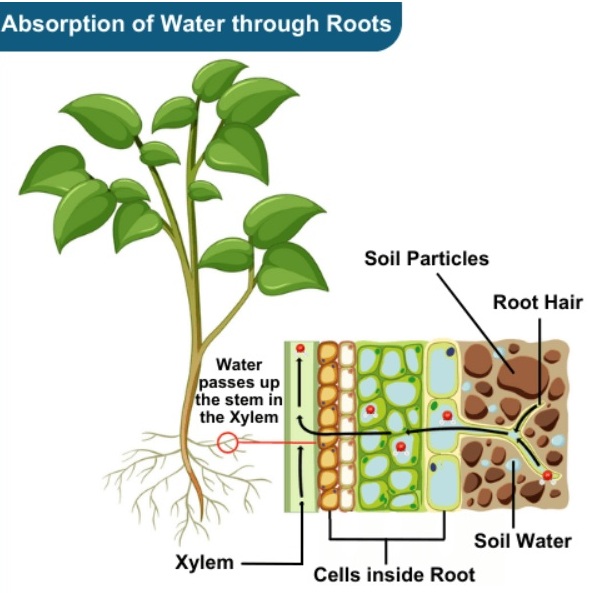
Transportation through Vascular Tissues
After absorption in the roots, water and minerals need to be transported to other parts of the plant. This transportation occurs through specialised tissues called vascular tissues, which consist of two main types: xylem and phloem.
Xylem
- Xylem is like the plant's "water pipes." It carries water and minerals from the roots up to the rest of the plant, such as the stems, leaves, and flowers.
- It works in a one-way direction, mostly moving the water upwards. It's similar to how water moves up a straw when you suck on it. Xylem helps deliver water to all the different parts of the plant.
Phloem
- Phloem is like the plant's "food delivery system." It transports the food, which is in the form of sugars, from the leaves to other parts of the plant, like the roots and storage organs. This process is called translocation.
- Unlike xylem, which only moves water in one direction, phloem can transport food in both upward and downward directions. It's like a two-way road that carries the sugars to wherever they are needed.
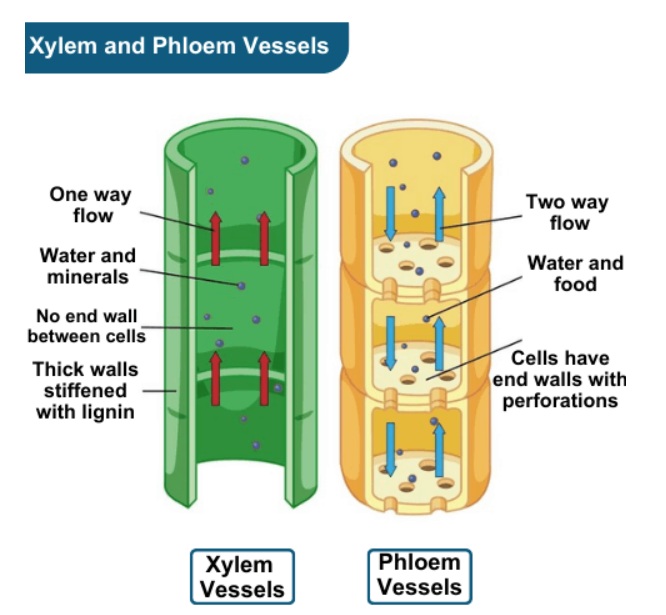
Translocation and Transpiration
Translocation
a) Translocation is the process by which the food (sugars) produced in the leaves is transported to other parts of the plant through the phloem tissue. It involves active transport and allows the plant to distribute the sugars to areas where they are needed for growth, energy, and storage.
b) During photosynthesis, leaves produce sugars, which are a form of food for the plant. These sugars, such as glucose, are synthesised in the chloroplasts of leaf cells using sunlight, carbon dioxide, and water.
c) After being produced in the leaves, the sugars need to be distributed to other parts of the plant, such as the roots, stems, and storage organs. This is where translocation comes into action.
Transpiration
a) Transpiration is when plants lose water in the form of water vapour through tiny openings on their leaves called stomata.
b) When water on the leaves evaporates, it creates a kind of "suction" or pull that helps draw more water up from the roots to the leaves. It's similar to when you use a straw to drink a liquid, and the sucking action pulls the liquid up.
c) This upward pull of water is important for plants because it helps transport water and nutrients from the roots to the rest of the plant. It's like a pipeline that delivers water and nutrients to all the parts of the plant that need them.
d) In addition to its role in water transport, transpiration also has a cooling effect on the plant. The process of transpiration helps regulate the plant's temperature and prevents it from getting too hot.
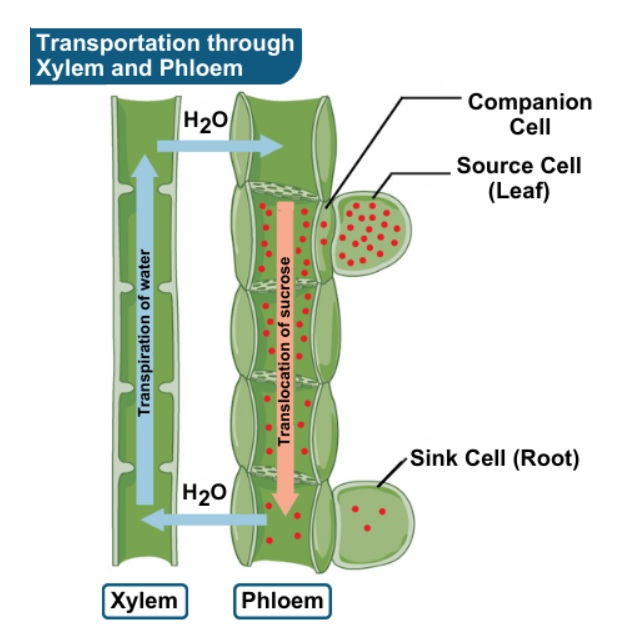
Transportation in Animals
- Animals, just like humans, need to transport important substances throughout their bodies to support their survival and bodily functions. The transportation system in animals is called the circulatory system.
- The circulatory system in animals is responsible for the transportation of vital materials such as oxygen, nutrients, hormones, and waste products. It consists of three main components: the heart, blood, and blood vessels.
- Blood: Blood is a specialised fluid that carries substances throughout the body.
- Blood Vessels: Blood vessels are like a network of tubes that carry blood to different parts of the body. There are three types of blood vessels: arteries, veins, and capillaries.
- Heart: The heart is a muscular organ that acts as a pump. It continuously contracts and relaxes to pump blood throughout the body.
- Together, the heart, blood, and blood vessels work in harmony to transport substances throughout the body. Oxygen and nutrients are delivered to cells to provide energy and support growth and repair. Waste products, such as carbon dioxide, are carried away from the cells to be eliminated from the body.
- The circulatory system is essential for the overall functioning and well-being of animals. It ensures that all parts of the body receive the necessary materials for their proper functioning and removes waste materials from the body.
The Circulatory System
Blood
Blood is an important fluid that circulates throughout our bodies. It has a red colour and plays a crucial role in transporting nutrients, oxygen, and waste products.
I. Components of Blood
Blood consists of plasma, which is the liquid part, and three types of blood cells: red blood cells, white blood cells, and platelets.
1. Plasma: Plasma is the liquid part of blood. It mainly consists of water and contains dissolved substances like proteins. Plasma acts as a medium for blood cells to move around in the body.
2. Blood Cells: Blood contains three types of cells: red blood cells (RBCs), white blood cells (WBCs), and platelets.
- Red Blood Cells: Red blood cells have a disc-like shape. They contain a protein called haemoglobin, which gives blood its red colour. Haemoglobin helps carry oxygen from the lungs to all the cells in our body. It also helps transport carbon dioxide from the body's cells back to the lungs to be exhaled.
- White Blood Cells: White blood cells are slightly larger than red blood cells and are colourless. White blood cells are like the soldiers of our body's defence system. They help fight against diseases and infections by identifying and destroying harmful invaders like bacteria and viruses. They can move on their own and change their shape to reach infected areas.
- Platelets: Platelets are colourless blood cells that are smaller than red blood cells. Their main job is to help with blood clotting. When we get injured and start bleeding, platelets rush to the injured site and form clumps to stop the bleeding. This clotting process prevents excessive blood loss.
II. Oxygenated and Deoxygenated Blood
- Blood plays a crucial role in carrying oxygen and nutrients throughout your body. It comes in two different forms: oxygenated and deoxygenated.
- Deoxygenated Blood: Deoxygenated blood is also referred to as "used" or "deoxygenated" blood. It is blood that has delivered oxygen to the body's cells and has picked up waste products like carbon dioxide. Deoxygenated blood appears darker in colour because it contains less oxygen. This blood returns to the heart to be reoxygenated.
- Oxygenated Blood: Oxygenated blood is rich in oxygen. It carries this oxygen to various parts of the body to provide energy for cells to function properly. Oxygenated blood appears brighter or redder due to the higher oxygen content.
Blood Vessels
Blood vessels are tube-like structures that carry blood throughout the body. There are three types of blood vessels:
I. Arteries
- Arteries carry oxygenated blood from the heart to all parts of the body, except for the pulmonary artery, which carries deoxygenated blood from the heart to the lungs.
- Arteries have thick walls to withstand the high pressure of blood being pumped from the heart.
- They branch out into smaller vessels called arterioles.
II. Veins
- Veins carry deoxygenated blood (except for the pulmonary vein) from different parts of the body back to the heart.
- Veins have thinner walls compared to arteries and contain valves that help prevent the backward flow of blood. These valves ensure that blood flows in the right direction towards the heart.
- The pulmonary vein is an exception among veins as it carries oxygenated blood from the lungs to the heart.
III. Capillaries
- Capillaries are tiny and thin-walled blood vessels that connect arteries to veins.
- Capillaries are where the exchange of oxygen, nutrients, and waste products occurs between the blood and the body's cells.
- Oxygen and nutrients pass from the capillaries into the surrounding tissues, while waste products like carbon dioxide move from the tissues into the capillaries to be carried away.
Human Heart
I. Structure
The heart is a powerful organ with four chambers that pump blood to different parts of your body. It has valves to ensure the blood flows in one direction. Deoxygenated blood is sent to the lungs to pick up oxygen, while oxygenated blood is distributed throughout the body.
- Four Chambers: The heart has four chambers to prevent oxygenated and deoxygenated blood from mixing. The upper chambers are called the atria, and the lower chambers are called the ventricles. This separation ensures that the blood flows in the right direction.
- Right and Left Sides: The heart has a right side and a left side. The right side receives deoxygenated blood rich in carbon dioxide from the body, while the left side receives oxygenated blood from the lungs.
- Septum: The heart is divided by a partition called the septum, which completely separates the right and left sides. This prevents the mixing of blood and ensures that oxygenated and deoxygenated blood stay separate.
- Valves: The heart has valves that act as one-way doors, preventing the backflow of blood. This allows the blood to flow in one direction, from the atria to the ventricles and then out of the heart.
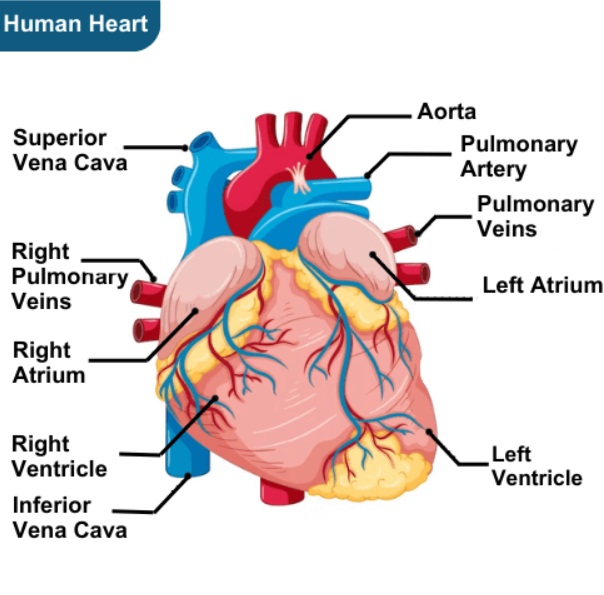
II. Blood Flow in the Heart
1. Deoxygenated Blood
a) Deoxygenated blood from all parts of the body enters the heart through a large vein called the vena cava, which brings the blood to the right atrium.
b) From there, it moves to the right ventricle, which pumps the blood into the pulmonary artery.
c) The pulmonary artery carries the blood to the lungs, where it picks up oxygen and gets rid of carbon dioxide.
2. Oxygenated Blood
a) Oxygenated blood, rich in oxygen, returns to the heart through the pulmonary veins. It enters the left atrium and then moves into the left ventricle.
b) The left ventricle pumps this oxygenated blood into the aorta, the main artery of the body, which delivers the blood to all parts of the body.
III. Heart Rate and Pulse
Heart Rate: The human heart beats around 72 times per minute on average. This is known as the heart rate, which is the number of times your heart beats in one minute.
Pulse: When your heart beats, it creates a pulsating movement that can be felt in certain places, such as the wrist. This pulsation is called the pulse. Your pulse rate is the number of times you feel your pulse in one minute. It helps measure your heart rate.
IV. Blood Circulation in the Heart and Body
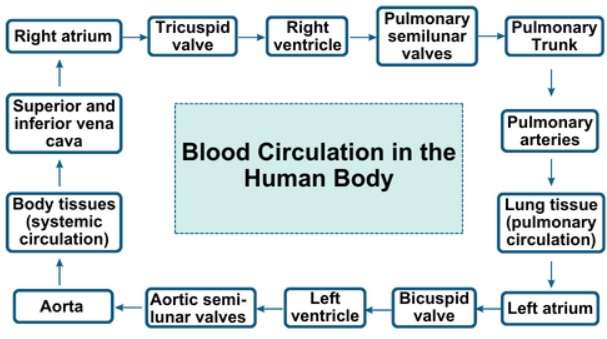
Human Excretory System
- The excretory system and the transportation system in humans are connected in terms of the removal and transportation of waste products.
- While the transportation system, specifically the circulatory system, is responsible for delivering oxygen, nutrients, and other essential substances to various parts of the body, the excretory system plays a role in removing waste products from the body.
Parts and Functions of the Excretory System
Kidneys: The kidneys are like filters in our body. We have a pair of kidneys that filter waste from the blood. They help remove substances like excess water, salts, and toxins. The waste material filtered by the kidneys is then eliminated from the body in the form of urine.
Ureters: Urine, the waste liquid produced by the kidneys, passes from each kidney through narrow tubes called ureters. These ureters act as pathways, transporting urine from the kidneys to the urinary bladder.
Urinary Bladder: The urinary bladder is like a storage tank for urine. It collects and temporarily stores the urine that comes from the kidneys through the ureters. The bladder expands as it fills up with urine and contracts when it's time to release the urine from the body.
Urethra and Urinary Opening: The urethra is a tube that connects the urinary bladder to the outside of the body. It serves as a passage for urine to exit the body. The urinary opening, located at the end of the urethra, allows urine to be excreted from our body.
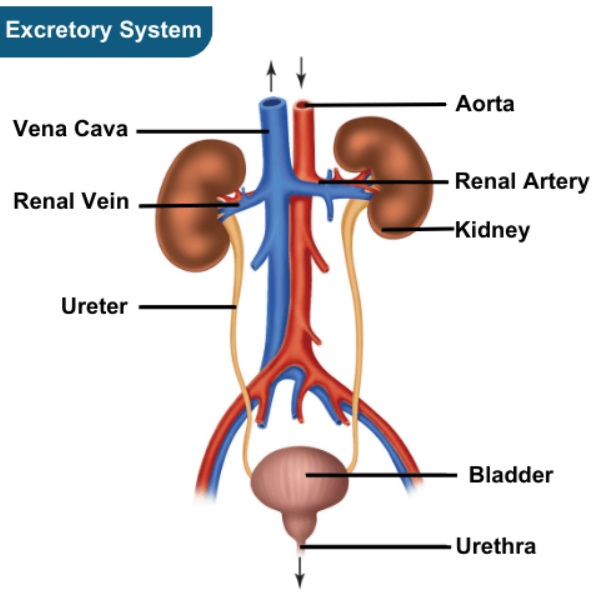
Additional Elimination of Waste
Apart from the kidneys and urinary system, there is another way our body eliminates waste:
Sweat Glands: Our skin has tiny sweat glands that play a role in eliminating waste. These sweat glands help remove waste substances like salts and urea from our bodies through sweat. Sweating also helps cool down our body, regulating its temperature.

